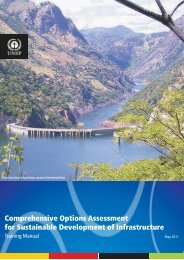MEASURING WATER USE IN A GREEN ECONOMY - UNEP
MEASURING WATER USE IN A GREEN ECONOMY - UNEP
MEASURING WATER USE IN A GREEN ECONOMY - UNEP
You also want an ePaper? Increase the reach of your titles
YUMPU automatically turns print PDFs into web optimized ePapers that Google loves.
Measuring water use in a green economy<br />
5 Summary<br />
and Conclusions<br />
5.1 Water connects<br />
This report provides a link between the reality<br />
of the serious and concerning status of our<br />
water resources due to increasing pressures<br />
of all kinds and the measures that are feasible<br />
and under development in many parts of<br />
the world, but that need implementation. It<br />
is one in a series of three reports by the UN<br />
International Resource Panel (IRP) dealing with<br />
water resources in the context of global change<br />
and scarcer resources that call for a major<br />
transformation in the global economy.<br />
Water in the development of a Green<br />
Economy is vital in three ways: it is an asset<br />
essential for life and a common good for<br />
human well-being, it is a production factor<br />
and economic asset essential for economic<br />
prosperity, and, integrating these two, it is<br />
a vital environmental asset essential for the<br />
maintenance and regulation of the ecosystem<br />
services that ensure the long-term sustainable<br />
provision of the economic and social goods and<br />
services on which prosperity depends.<br />
This gives sustainable water management a<br />
key role in integrated actions and activities<br />
to structure a new, green economy and can<br />
thus provide a pilot for a paradigm shift<br />
towards the integration of economic, social and<br />
environmental principles.<br />
Water connects. It connects air with land.<br />
It connects regions, cultures, opinions and<br />
different (economic) interests.<br />
The missing link between the need for<br />
change and action to implement this change<br />
is information and knowledge of the exact<br />
scope, character and location of the problem to<br />
inform all actors, offering possible measures,<br />
justifying target setting and balancing actions<br />
and policy options in the most effective way.<br />
Many examples of good or difficult water<br />
management around the world show that<br />
objective and targeted information can unblock<br />
the stakeholder dialogue on which the crosssectoral<br />
understanding of efficient water<br />
management so much depends.<br />
5.2 Quantifying water use<br />
in the local and global<br />
perspective for crosssectoral<br />
sustainable<br />
water management<br />
Water as a resource differs strikingly from<br />
resources like metals, oil or coal, dealt with in<br />
previous <strong>UNEP</strong> reports (<strong>UNEP</strong>, 2011a). Water<br />
management is a mix of local, continental and<br />
global matters, but most water management is<br />
driven by local conditions in local catchments<br />
and ruled by regional or local governance<br />
structures, which involve governmental policy<br />
actions as well as private sector activities<br />
and behaviour of the different stakeholders<br />
(civil society, farmers, industries enterprises,<br />
utilities, etc.).<br />
All regional and local management is of course<br />
to be seen in a pan-regional and even global<br />
context. Some aspects of water management<br />
are directly dependent on agreements and<br />
cooperation in transboundary river basins (e.g.<br />
Rhine or Danube in Europe), are related to<br />
73

















